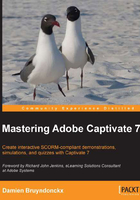
The inner working of the Captivate capture engine
The Captivate capture engine is based on screenshots. Going back to the Adobe Media Encoder project, let's review what exactly happened when you clicked on your mouse during the capture using the following steps:
- Return to the
Chapter02/encoderDemo_1_1024.cptxfile. - Make sure that the first slide is selected in the Filmstrip panel.
The first slide shows the initial state of the application. When filming, you used your mouse to click on the Add Source icon of AME. When you clicked on this icon, Captivate launched a sequence of actions behind the scenes:
- Captivate recorded the position of the mouse at the time of the click (using X, Y coordinates)
- Adobe Media Encoder executed the action
- When Adobe Media Encoder completed its action, Captivate took a static screenshot of the new state of the application (the second slide)
You then used your mouse a second time to double-click on the demo_en.mov file. When this second click occurred, Captivate launched the same sequence of actions and took a third screenshot to generate slide 3.
When the movie plays, the static screenshot of the first slide (a .bmp image) is displayed. When the mouse has to move, Captivate recreates a movement from the top-left corner of the slide to the position of the click as recorded during the filming. Just after the click, Captivate displays the static (.bmp) screenshot of slide 2.
When it is time to move the mouse slide 2, Captivate recreates a movement from where the click occurred on slide 1 to the location of the click slide 2 as recorded during the filming. Right after the second click, Captivate displays the third static screenshot. This process repeats itself till the end of the movie.
It may sound very simple and logical, but the way this process works has lots of implications, as mentioned in the following list:
- Only the starting points and the ending points of the mouse movements are recorded by Captivate. During the playback, a movement is recreated between these points.
- Every mouse movement made during the filming between two clicks is therefore not recorded.
- The animations displayed by the Captured application (in this case, the progression of the yellowish bar during encoding) are not captured.
- The Timeline of the generated movie is independent of the time that has passed during filming.
This system creates a very lightweight animation. A bunch of images and a few coordinates are enough to reproduce an entire movie.
However, this system is limited. Some mouse actions, such as drag-and-drop and scrolling actions, cannot be reproduced that way. These actions require an actual frame-by-frame video recording to be played back correctly. Such a frame-by-frame animation is known as Full Motion Recording (FMR).
The Full Motion Recording mode
To make sure you understand this concept, let's take a look at some of the preferences of Captivate:
- In Captivate, navigate to the Edit | Preferences (Windows) or Adobe Captivate | Preferences (Mac) menu item to open the Preferences window.
- Once the Preferences window opens, click on the Settings category in the Recording group as illustrated in the following screenshot:

Notice at the end of the Preferences window two options that help you control the Full Motion Recording behavior of Captivate: Smoothen movements for Drag and Drop actions and Smoothen movements for Mouse Wheel Actions.
These two options are selected by default, and you should not tamper with them unless you have a good reason to. Thanks to those two boxes, Captivate automatically switches to the Full Motion Recording mode when a drag-and-drop or a mouse wheel action is detected during the filming:
- Close the Preferences window.
- Take a close look at the icons situated in the bottom-right corner of each slide's thumbnail in the Filmstrip window.
While most of the slides display the icon of a mouse, one slide should display the icon of a video camera. This is shown in the following screenshot:

The preceding screenshot is the slide where the scrolling movement on the Video tab of AME occurs.
Thanks to the Smoothen movements for Drag and Drop actions and Smoothen movements for Mouse Wheel Actions options being turned on, Captivate has detected this scrolling movement and has automatically switched to the Full Motion Recoding mode when capturing that particular slide.
One of the limitations of Full Motion Recording is that it does not allow any kind of interaction. During the playback, the student cannot perform such scrolling movement, themselves.
The Full Motion Recording mode will also help you to capture the progression of the yellowish bar at the end of the project. The only thing is that the yellowish progression bar is not linked to any scrolling or drag-and-drop action. Fortunately, there is another way to control the Full Motion Recording mode.